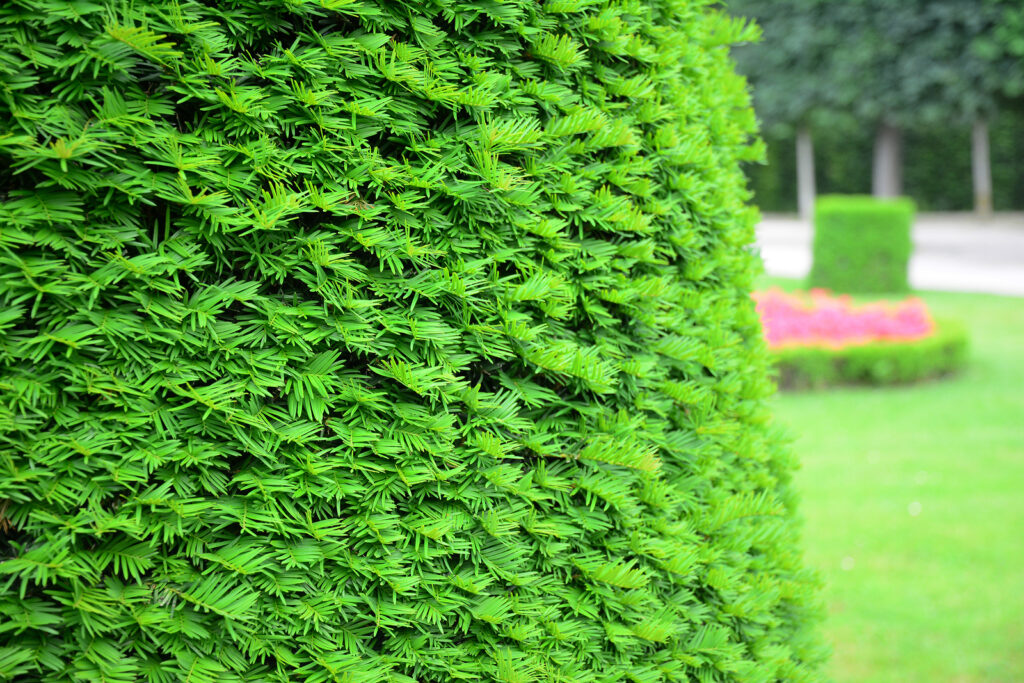Taxus — commonly called yew–are broadly rounded to upright and columnar evergreen coniferous large shrubs and trees. Taxus can be grown as trees or shrubs. They can be used as specimens or used as hedges or topiaries.
Taxus have linear, dark green leaves, often paler beneath. The leaves are spirally arranged.
Taxus are conifers but they do not bear cones. Instead they produce fleshy, scarlet, single-seeded fruits.
Taxus are generally considered more formal and darker green than most conifers. They are also more tolerant of shade and moist soil than most conifers. They are long-lived and easily stand up to shearing and pruning. They are excellent for screens and hedges.
The Taxus genus contains 5 to 10 species; they are found in most northern temperate regions.

Get to know Taxus
- Plant type: Evergreen shrubs or trees
- Growing zones and range: Zones 4 or 5 to 8
- Hardiness: Hardy to Zone 4
- Height and width: Shrubs 4 to 12 feet (1.2-3.6m) tall and wide; trees 25 to 40 feet (7.6-12m) tall and half as wide
- Growth rate: Slow to medium
- Form and habit: Long upright branches form a columnar habit
- Foliage: Glossy dark green needle-like foliage is spirally arranged
- Flowers: Inconspicuous
- Fruits: Fleshy, scarlet red (rarely yellow), cup-shaped, single-seed, seedlike fruits
- Uses: Tall hedges, screening, walls, topiary, and specimen
- Common name: Yes
- Botanical name: Taxus
- Family name: Taxaceae
- Origin: Northern temperate regions
Where to plant Taxus
- Plant Taxus in full sun or partial shade.
- Plant Taxus in well-drained, humusy, fertile soil; pH 6.0 to 7.0.
- Most Taxus need some protection from harsh winds and extreme heat.
- Heat will burn foliage; even cold-hardy kinds of Taxus show needle damage when exposed to dry winds, very low temperatures.

When to plant Taxus
- Transplant container-grown or balled-and-burlapped Taxus with care in early spring or fall.
Planting and spacing Taxus
- Space shrubs 4 to 12 feet (1.2-3.6m) apart.
- Space trees 25 feet (7.6m) apart.
How to water and feed Taxus
- Give Taxus regular to moderate water.
- During prolonged hot, dry weather, hose off Taxus plants every 2 weeks.
- Feed Taxus with an all-purpose organic fertilizer in spring.
How to prune and care for Taxus
- Pruning season for Taxus is early spring.
- Taxus is tolerant of excessive pruning throughout the growing season.
- To keep a Taxus hedge compact, follow an early spring pruning with the removal of the soft new summer growth.
Taxus pests and diseases
- Taxus is disease resistant.
- Taxus seeds and foliage contain poisonous compounds, so be aware if you have children or pets.
- Taxus is susceptible to attacks by vine weevils, mealybugs, scale insects, and various fungus diseases.

Taxus propagation
- Propagate Taxus by cuttings collected in winter.
- Sow seed when ripe in containers in a cold frame; seed can take 2 or more years to germinate.
Taxus varieties to grow
- Taxus bacata, English yew, used for foundation plantings throughout the East, where they grow in Zones 5 or 6 to 7 or 8. Most shrubby forms grow to be twice as wide as they are tall, but ‘Adpressa Fowle’ is a good hedge plant with a mature size of 6 feet (1.8m) by 16 feet (4.9m). Unique among evergreens in its tolerance for shade, it does best in a pH range of 7.0 to 7.5. ‘Aurea’ has golden needles. ‘Stricta’, a columnar form is also known as the Irish Yew, makes a handsome 15-30 foot (4.6-9.1m) screen.
- T. brevifolia, Western yew, Oregon yew, most trees sold under this name are actually T. cuspidata ‘Nana’. True western yew is a rare, 50-60 feet (15.2-18.3m) tree of northwestern woodlands. It has achieved some fame as the source of a drug used in treatment of some cancers. Not a garden tree.
- T. cuspidata, Japanese yew, can be grown in Zones 4 to 7. Because it is so cold hardy, Japanese yew is the most common yew grown in North American landscapes. It can form a multi-trunked, 25-40 foot (7.6-12.2m) tall tree with upright or spreading branches, but dwarf types are grown more often than the species. Needles are 1 inch (2.5cm) long and pointed. They emerge bright green in spring, creating an eye-catching contrast against the very dark green older needles, which have yellowish-green undersides. Needles are arranged in two irregular ranks on all shoots, which have brown bark. This yew makes an excellent hedge or screen. It can also be used as a specimen in a mixed border or shady garden. From Japan to Korea. The dwarf ‘Nana’, 3 feet by 6 feet, is one of the most popular.
- T. media, group of hybrids between Japanese yew and English yew. Intermediate between the two in color and texture.
- T. x media, a cross between the English and Japanese yews, grows in the Midwest and West in Zones 4 or 5 to 8. There’s a size for every purpose, from compact, 3 foot (.9m) ‘Flemer’, to 4-5 foot (1.2-1.5m) ‘Densiformis’, to 6 foot (1.8m) ‘Brownii’, and the longtime columnar 12 foot (3.7m) favorite, ‘Hicksii’ and T. X media ‘Hatfieldii’.















